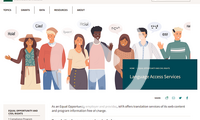Health Care & Welfare Benefits
Recent Activity

This webinar examines the challenges that refugees and other migrants face in—and place on—secondary cities, municipal capacity to respond to needs, the types of support required at national and other levels, and how development actors can better partner with secondary cities and local actors.

White House and Department of Health and Human Services officials join a leading language access advocate and MPI's Margie McHugh in a conversation exploring executive-branch efforts related to language access provision, upcoming actions, and opportunities to improve the provision of information and services in languages other than English in federal programs.
Marking the launch of a report by the American Academy of Pediatrics and MPI, this event examines unaccompanied children’s access to medical and mental health services post-release and offering recommendations for improvements.
The presidents of Colombia and Ecuador speak at this high-level event held on the sidelines of the Ninth Summit of the Americas, focusing on the critical need for succcessful integration of Venezuelans in the Americas.

With COVID-19 likely to significantly reshape health-care systems in Europe and worldwide, there is a window of opportunity to test new strategies to tackle longstanding migrant health disparities, and ensure that structural changes accommodate the complex needs of diverse populations.
Pages
Recent Activity
The COVID-19 pandemic hit South American nations at a time when many were already contending with major migration challenges. Historic levels of intraregional migration and displacement, notably from Venezuela, collided with countries’ attempts to stop the spread of a new threat to public health. This report examines the region’s responses to the public-health crisis, and the immediate and lasting impacts on cross-border movement.















The Public-Charge Final Rule Is Far from the Last Word
Different Statuses, Different Benefits: Determining Federal Assistance for Afghan Evacuees
A Solvable Challenge: Improving Asylee Access to Health and Other Benefits
The Role of Immigrant Health-Care Professionals in the United States during the Pandemic
How the Fear of Immigration Enforcement Affects the Mental Health of Latino Youth
Anticipated “Chilling Effects” of the Public-Charge Rule Are Real: Census Data Reflect Steep Decline in Benefits Use by Immigrant Families
The Public-Charge Rule: Broad Impacts, But Few Will Be Denied Green Cards Based on Actual Benefits Use
Health Insurance Test for Green-Card Applicants Could Sharply Cut Future U.S. Legal Immigration
Millions Will Feel Chilling Effects of U.S. Public-Charge Rule That Is Also Likely to Reshape Legal Immigration
Through the Back Door: Remaking the Immigration System via the Expected “Public-Charge” Rule
Pages